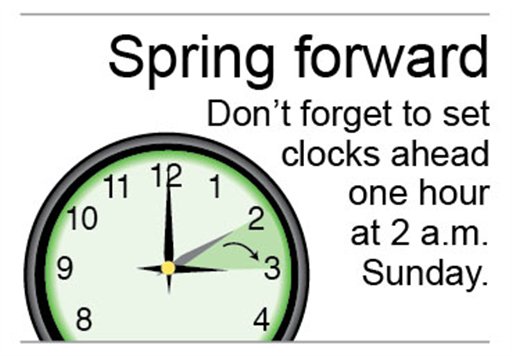 For some, it is the day most dreaded. No, not April 15 and the deadline for income tax returns, this one is even worse. It’s Daylight Savings Time and it begins Sunday, March 13, 2016 at 2 a.m. It is officially the hour in which time will “spring forward” and without proper planning you will lose an hour of sleep.
For some, it is the day most dreaded. No, not April 15 and the deadline for income tax returns, this one is even worse. It’s Daylight Savings Time and it begins Sunday, March 13, 2016 at 2 a.m. It is officially the hour in which time will “spring forward” and without proper planning you will lose an hour of sleep.
Why Daylight Savings Time? The original answer was to save energy costs and to have more daylight for activities during warmer weather. However, recent studies are challenging the energy savings idea. Energy use and demand for electricity is connected to when we get up and when we go to bed—think lights and TV and open refrigerators during commerical breaks. In a 1970’s study by the U S Department of Transportation, the entire nation’s electricity usage was cut by about 1% each day with Daylight Savings Time.
Although Ben Franklin suggested DST in 1784, the Uniform Time Act of 1966 provided the basis for alternating between DST and Standard Time. In 1973, Daylight Savings Time was observed all year. In 1986, Congress declared that 2 a.m. the first Sunday in April would begin DST and the last Sunday of October would return to Standard Time. Halloween got in the way. In 2007, Congress moved the end of DST to the first Sunday of November.
Whether you lose the hour of sleep or you plan your evening schedule to accomplish the hour before arising Sunday morning for that much needed cup of coffee before worship, work, or whatever, the greater effect of the day is on your circadian rhythm. It can take up to one week before your body adjusts to the time change according to Harvard Health. That lack of sleep often leads to irritability, lack of focus, and a weakened immune system which create a number of health problems.
Speaking of Health issues, studies over the past several years have shown that the heart attack rate increases during the first few days following the time change. Workplace and motor vehicle accidents spike as well during the week following the time change.
It you want to limit the effect of the spring forward there are a few steps to take. Stick to a schedule that will prioritize bedtime around the same hour each night, even with the time change. Alcohol and caffeine intake also affect your sleep. Both contribute to sleep interrupted. Cut off caffeine and alcohol intake at least two (2) hours before bedtime. Exercise during the day but do not exercise within two hours of bedtime.
Like it or not, Daylight Savings Time will be with us until November 6 this year. The only way to escape it is to move to Hawaii, American Samoa, Guam, Puerto Rico, the Virgin Islands, the Commonwealth of Northern Mariana Islands, or Arizona. But in Arizona, don’t take up residence on the Navajo Nation, which does participate in DST.





